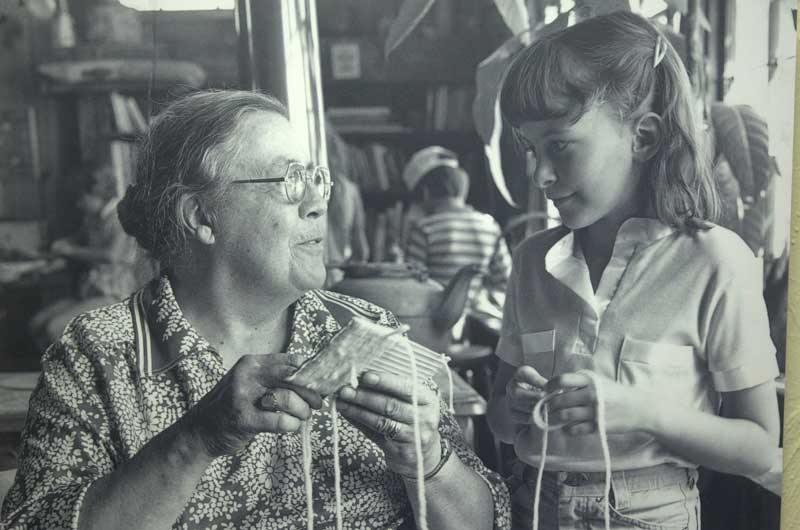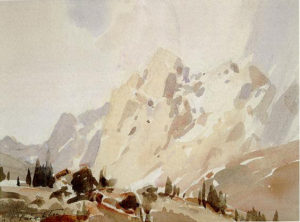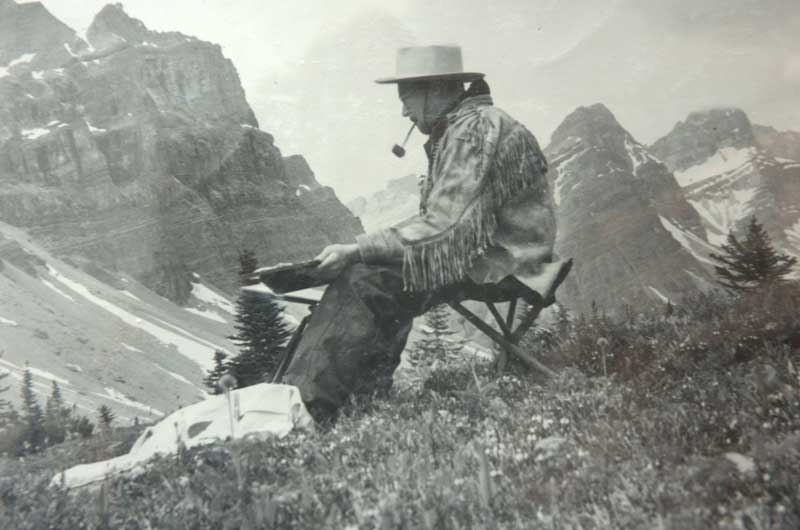Dear Artist,
Last Friday I gave a talk to fifty artists at the Leighton Art Centre near Calgary, Alberta. Formerly the home and studio of Barbara and A.C. Leighton (1901-1965), it commands a spectacular view of the Rocky Mountain foothills. Leighton was an individualist Englishman whose life was one of constant movement. For me, it felt good to be back in his great room and in the Leighton presence. While I knew Barbara well, I met A.C. only once, a year or two before he died. A callow youth, I was having my first show in Calgary. Leighton walked briskly in and stood for a moment in his long black coat while the room hushed. Frowning, he quickly cruised the gallery and suddenly pointed to one of my paintings. “That one is okay,” he said. I shook his hand with boyish glee — then he was gone.
As a young man, Leighton had shown promise in British art schools. The Canadian Pacific Railway noticed his ability and sponsored him to come out and paint the Rockies. When he got to Banff, he was smitten. A compulsive painter, Leighton worked up his ideas in fresh watercolours with an English sensibility. Oils followed. One could say that he was a stubborn purist, one of those immigrants who never quite left England. Year after year he and Barbara went back “for the better physicians and to paint in the Surrey countryside.”
While Leighton’s rigidity brought expectations of himself that could never be attained, it also empowered his vision. A.C. was never contented. It’s rumoured that shortly before he died, he buried hundreds of his works somewhere on his 80 acres. While I continue to hold onto many of my dogs, I often think of his recorded remarks and the A.C. wisdom that Barbara generously threw at me:
“The true artist paints for himself.” “He seeks achievement and does not need to be merely pretty.” “He consciously enters character into his work.” “He craves knowledge and must study continually to obtain it.” “Edges must be held by tone values, not lines.” “Use pleasing design and colour.” “The use of reds, yellows or blues in profusion is not good art, but if considerable grey is added, this softens their effect and shows them to advantage.” “One can live longest with the greys.” “Only top paintings hold interest for any length of time.” “The public cannot be expected to jury.” “Don’t do poor work, and if you do, don’t let it out.”
Best regards,
Robert
PS: “I soon found that a 10″ by 14″ was too small even to rough-in a composition, and something much larger was necessary to portray the magnitude, the imposing force and dignity of those mountains.” (A. C. Leighton)
Esoterica: Childless, and both of them artists, the Leightons were a force unto themselves. A story goes that two Red Cross volunteer collectors proceeded up the Leighton driveway only to find Barbara entwined “au naturel” in the wisteria while A.C. painted her. Barbara dropped her pose, quickly went inside, found some cash and gave it to them. “Hold the receipt,” she called to them as she went back to her pose — while a frowning A.C. never looked up from his concentration and never missed a stroke.
The work of A.C. Leighton

After A. C.’s death, Barbara ran an art and craft school at the Leighton home near Millarville, Alberta
Go west young man
by Karl Heerdt, Lockport, NY, USA
It is funny how one can see the small coincidences in life and realize that there are greater forces at work. The timing of your letter about A.C. Leighton and his ideals struck a chord with me, many of his thoughts and ideas about painting I myself subscribe to. The graying down of colors to show off more pure ones. The constant study. I always tell my students to constantly study and that they are only as good as their worst painting. I myself have burned my share of bad works. And the biggest coincidence is that a prominent northwest gallery will soon be sponsoring my trip out to the northwest to gather reference material for a show that I will be having there. They want me to paint Yellowstone, and all week I have seen specials on TV about… you guessed it, Yellowstone. Coincidence, or is there more to it?
Rugged conformer
by Anonymous
Mr. Leighton, as you describe him and as is seen in the literature, is not so much a rugged individualist as he is a rugged conformer to the standards then prevalent in England. He apparently brought these standards west and inflicted them on the wild Canadian landscape. While his watercolours, particularly, are of note for their looseness and brevity, the western landscape required an even bolder approach than he was able to give. One must not confuse “high” standards, with “rigid” standards.
Guidance for Art Associations
by John D. Stevenson, Gatineau, QC, Canada
I recently was a part of a three-day show held in our area. The show was presented by a small Art Association and, as per its charter, encouraged new young and old artists to show and sell their work. At the risk of being found superior, I think your quotations from A. C. Leighton would be and should be the basis for all Art Associations. I personally think that in the development of an artist one should learn to recognize when one’s own work is really exposing one’s soul to the world. Then the artist should rush to present their work to the world. Should members of the public feel in reaction something in their own soul, then they need to pay a fair price. But the selling of a painting should never be the prime reason for painting in the first place.
Pile in for the odyssey
by William Panzer, Houston, TX, USA
Since reading The Painter’s Keys I have shuffled my art in several piles:
Pile One: Works of merit. These are about sixty paintings that I am going to take to Taos… either will start a gallery there for the summer or maybe just stop on the side of the road in Truchias or some other beautiful spot. From there I plan to go to San Miguel de Allende for the fall months and do a couple of shows. Also, I will use some of these paintings to apply to do a two month show in Scottsdale in early 2008.
Pile Two: Works that need completion.
Pile Three: Works that need to be gessoed over.
Pile Four: Supports, Canvases, Panels that need to become new creations.
I am now going to load all of Pile One and several from the other piles and head out on an odyssey. I am subletting my Houston studio and will spend ten months in my Motorhome/ Studio.
Excited to be among women
by Anonymous,
I’m 51 and have worked for 30 years in a non-creative atmosphere in a non-creative, testosterone heavy industry (construction), hesitant to let my “girlie, creative” side out — until recently. The response to my pumpkin carvings the last few years have been phenomenal. The response to my woodcarvings, turnings and photography is very positive, while the watercolors have been admired by many. That’s all nice, but I get a bigger kick of just knowing that I can do it and that I will never run out of things to create and improve on. But what I want to confess is the more than a little tingle of excitement that occurs when I experience the flow of creative energy when in a class, workshop, or studio situation. I’m 6’1″ and a big-boned, big-muscled 260 lb, but tender-hearted guy. I’m amazed at the feeling of being “crisply” alive and just out-and-out giddy. I go about my painting with a sense of childlike fun and amazement! It also doesn’t hurt that I’m usually the only male and that many of the ladies seem to be fascinated with a big, crusty, grey-haired, 51 year old man doing the painting thing. It really adds to my already big ego.
Freud out of style
by Jane Champagne, Southampton, ON, Canada
After reading the previous clickback, The mating game, it seems to me that your readers need a good dose of Carl Jung. He believed that women’s creativity was often invested in her man, and until she could claim that creativity as her own, she would not be able to paint, sculpt or whatever. Happened to me. Sigmund Freud went out of style decades ago; Jung had it right. The whole idea that women paint to attract a mate is ridiculous in the first place — we paint because we want to, need to, just like any man does. I doubt many women were consulted before Geoffrey Miller wrote his opus — it is nonsense to state that the mating game is what motivates painters. You know better than that, Robert.
Pheromones both ways
by Cathy Johnson, MO, USA
Your letter on The Mating Game made me smile with delight — you’re right on the money! My love is quite taken with my creative pheromones… and it works both ways. I’ve done some figure drawings of him that I find wonderfully pleasing — not because my work is perfect, but because I captured something of his essence, the way his thigh turns gracefully from the hip, the long line of the spine, the vulnerable back of the knee, the broad shoulders, the back of the neck. Yes, art and the mating game… what a matchmaker!
Artist can’t resist dazzling
by Liz Reday, South Pasadena, CA, USA
In the great game of “having a show,” we display our paintings on the walls of our stage, whether it’s an upscale gallery, an edgy downtown space or a humble outdoor booth show. Surrounded by our finished work, the artist enters, stage right. The audience mills around, surveying the work with one eye while waiting for the actor/artist to make their move. Will the artist quail under pressure, modestly playing the part of shrinking violet? Or will the artist come alive in the spotlight, knowing that these moments are few and far between? Sure, the work should speak for itself, but for this one moment in time, we can dazzle. How could we resist?
On mating and squinting
by Peter Brown, Oakland, CA, USA
I found it interesting to read the Mating Game clickback. Your correspondents should consider that there are many varieties of creativity — many arts and many occupations that require creative intelligence. Attractive, even sexy creativity is in no way limited to the visual arts, nor even to other obvious creative activities, such as music, writing and dance. There are also surgeons and plumbers, teachers and librarians. I have always thought that it’s much more important what a person is than what a person does. Creative energy underlies all positive forms of human endeavor. There are many artists in this world who do not make tracks. Look for a creative attitude and forget the predetermined portfolio.
Regarding your recent letter on squinting, I include an image of my Grasshopper Eye viewing device. I am guessing that it is more than 20 years old. It has great predictive applications for adding a new color to a work-in-progress when used with a color swatch. It has been a mainstay of my painting workshops and critiques.
Art and stages of human growth
by Nazanin Dadada, Iran
As you know, we are all growing mentally and physically and changing all the time as we learn what life is trying to tell us. I’m 22 and in my studies I read about different schools of art and about different artists with various opinions about life and art. Is there a relation between a human being’s stages of growth, growing mentally and emotionally, and schools of art? In other words, is art growing while our thoughts grow and, if it is true, why those great artists of the past couldn’t agree with new opinions about art?
(RG note) Thanks, Nazanin. The idea that different schools of art might parallel the development of a child, just as a fetus goes through various stages of animal evolution as it develops, is possible, but not likely. A child’s drawing ability, for example, leaves the automatic, atavistic stage very early on, and falls rather into learned, acculturated expressions and peer expectations. If there was some way of isolating an individual child from her society, there might be a discernible parallel. Schools of art and art movements are rather like hemlines, they rise and fall in fickle and inexplicable manners.
Revelstoke’s local Leighton
by Margo Goodman, Revelstoke, BC, Canada
The Canadian Pacific Railway also hired another English Artist to document through paintings. She passed through Revelstoke B.C. and travelled to Vancouver, painting. She later returned to Revelstoke where she lived out her life and returned to England to live out her last year. When in Revelstoke, she started up the Revelstoke Art Group in 1949. This group is still together & growing. She also gave lessons to many students, in her studio where she lived in a bording house. Her name was Sophia Atkinson. We are forever grateful to her for bringing art to Revelstoke.
Archived Comments
Enjoy the past comments below for A rugged individualist…
I look forward to this newsletter and even when I don’t have time to read it – I do. It fascinates me that one can put thoughts down twice a week about this journey that so many of us relate to. It stimulates me. I’ve noticed that I am passive about all the responses until I read a contrary one. Those are the ones that make me think, stir things up. I’m not very experienced yet but I am one that doesn’t always mind the rules. I appreciate when one thinks outside the box! Thanks to all of you.
San Jose, Ca.
Now I’ve heard it all! Never heard it said before that the higher the ceiling, the better the paInting. Thinking about it, one could use this as an excuse as to why one doesn’t improve when painting under a low ceiling – ha!
Oil Painting… How does one make an object have a glass-looking effect…?
It is true that a lot of people are attracted to creative souls. However, so many others are attracted to other characteristics. So, generalizing is, well, just that. Here’s one that I think is by far the most obvious. In “general,” women are attracted to fame, fortune, and/or power. In “general,” men are attracted to sex – especially when young. Both sexes are instinctively aware of this at an early age. Hense, many men seek fame, power, and fortune. Those who attain it will never run out of women waiting in line. Women in “general” wear clothes that are revealing and decorate their faces with make-up and shiny objects – because they “know” that even men without fame and power will pay to “be with them.” This dance between the sexes is and has always been the “elephant in the room” that most people are reluctant to admit!
I found the story about A.C. Leighton interesting. I also wondered how he was able to live. Being a pure artist really takes some doing, afterall one needs to take care of a lot of basic life stuff. Maybe living as artist wasn’t as difficult in Leighton’s time. I don’t think there were as many distractions many years ago as there are now as far as art is concerned. Not many artists have the ability to be a rugged individualist without great sacrifice.
No wonder I am having trouble being open and developing my style or a new way of working or finishing work to my satisfaction. My studio ceiling is only 7 1/2 feet high. I had better spend more time outdoors… but in the meantime I have a new excuse.
I feel creative. I experience sleepless nights struggling to bring out my innermost ideas in paint or pencil. BUT I never finish a work. I get sidetracked and read or doodle. At school when taking art exams I was told to map the subject out but do a part to a high finished standard. I am still doing this 20 years later. How do I make myself work harder. I feel I never have enough time. Any ideas ?

The Errand oil painting |
You may be interested to know that artists from every state in the USA, every province in Canada, and at least 115 countries worldwide have visited these pages since January 1, 2013.
That includes Moncy Barbour of Lynchburg, VA, USA who wrote, “Out of the mountains of artistic knowledge — differing as night and day, one must still find what works for oneself. It is all diversity. The world seeks different avenues. Are we not glad this is true?”
And also Jan Verhulst of Belgium who wrote, “Looking at the two paintings of A. C. Leighton you included, it seems to me that the watercolor, Evening, Pipestone Pass, is so strong and honest in its simplicity that it evocates the moment of that man, painting between these sublime mountains. I remembered again why I like watercolor so much.”
And also Annette Waterbeek who asked, “Did Mr. Leighton make his daily bread on the sale of his works? Sounds like he painted for himself.” (RG note) Thanks, Annette. A.C had the luxury of at least some inherited wealth. I don’t know how much. Thus he was able to indulge his idealism. Nevertheless he achieved a significant collectorship in Canada as well as in England.”
And Also Edna Hildebrandt who wrote, “Personal individualism is what makes an artist’s work stand out from the others.”
Artistic personal
Orange, CA, Single creative female, 46, seeking art-appreciating male. Must have sense of humor, sense of adventure, and common sense. Would love to meet you for an outdoor painting session by the beach or beautiful park, followed by a relaxing lunch and great art-filled conversation.
(RG note) We’ll continue these “Artistic Personals” if there is interest. Unless a seeker requests privacy, we will not assign a box number. The one in the previous clickback has received five replies so far — four of which seemed legitimate and have been passed on. There is no charge for this service. If it gets out of hand for whatever reason we will discontinue.


















